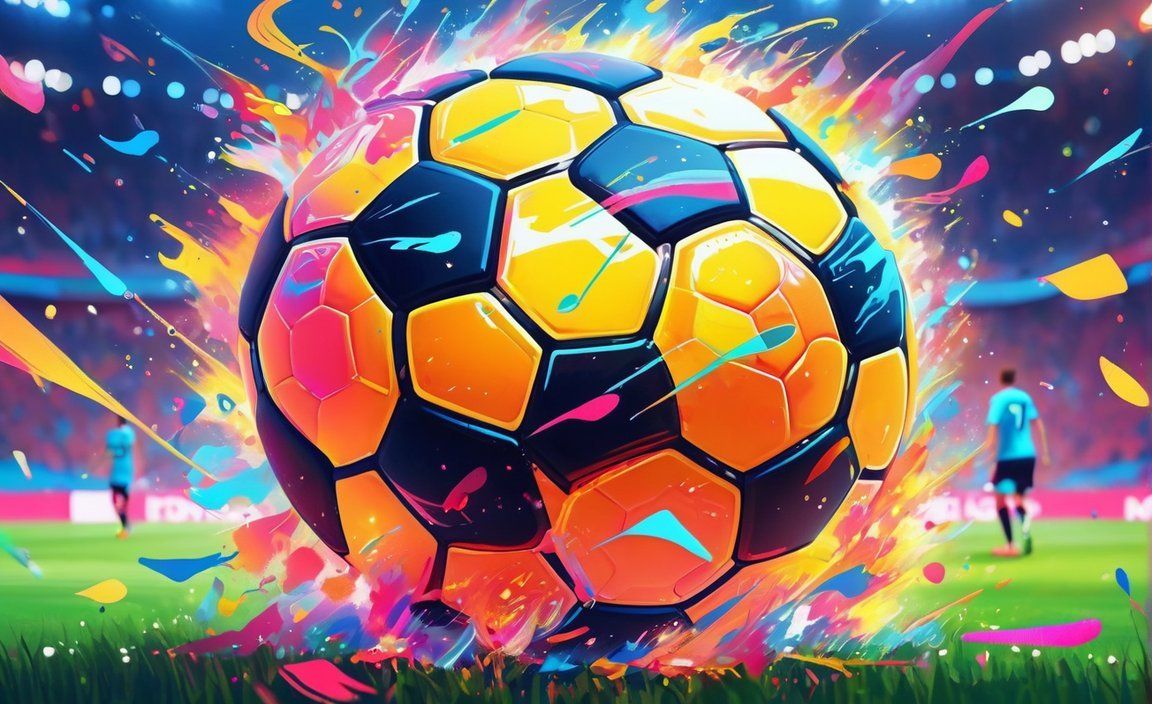Discover 10 Fun Soccer Facts and delve into the fascinating world of the beautiful game. Soccer, also known as football, is a sport loved by millions around the globe. Beyond the goals and thrilling matches, there are hidden gems of trivia that add an extra layer of intrigue to this beloved sport. From famous rivalries to quirky superstitions, this article uncovers ten entertaining and unexpected facts about soccer that will leave you amazed. So, let’s kick off and explore these captivating tidbits that make soccer a truly remarkable sport.
Key Takeaways:
- Soccer games typically last for 90 minutes.
- The earliest form of soccer can be traced back to China.
- Soccer originated in England.
- Modern soccer as we know it today began in 1863.
- Each player in soccer has a different position on the field.
- The goalkeeper plays a critical role in the game.
- Defenders are responsible for stopping the attacks of the opposing team.
- Midfielders are considered the engine of the team.
- The World Cup trophy has been redesigned.
- There is a separate World Cup tournament for women.
10 Fun Facts About Soccer

Soccer, also known as the beautiful game, has captured the hearts and minds of millions of fans around the world. From its rich history to its fascinating intricacies, there are numerous intriguing aspects that make soccer such a beloved sport. In this article, we will dive into 10 fun facts about soccer that will surprise and entertain you.
1. Soccer games are typically 90 minutes long
When you’re watching a soccer match, you might wonder why the game is divided into two halves of 45 minutes each. The reason for this can be traced back to the early days of the sport, when matches were played in a variety of durations. Eventually, the 90-minute format became the standard, and it has remained so ever since. The game is divided into two halves with a 15-minute break in between, allowing players to catch their breath and strategize for the second half.
2. The earliest form of soccer began in China
While soccer as we know it today originated in England, its roots can be traced back thousands of years to ancient China. The Chinese game, called “Cuju,” involved kicking a ball through a small net and was played as early as the third century BC. Cuju was not only a recreational activity, but it was also a military exercise and played a significant role in training soldiers.
3. Soccer originated in England
Although soccer may have evolved from ancient Chinese games, it was in England that the modern version of the sport took shape. In the early 19th century, various schools and universities across England began playing their own variations of soccer. These different forms of the game eventually led to the establishment of a set of standardized rules, known as the Laws of the Game, which were created by the Football Association in 1863. This landmark event marked the birth of modern soccer as we know it.
4. Modern soccer began in 1863
Following the establishment of the Laws of the Game in 1863, soccer grew rapidly in popularity and became a widely recognized sport around the world. The standardized rules brought consistency and fairness to the game, allowing teams from different regions to compete on an equal playing field. Today, soccer is played and enjoyed by countless people across every continent, making it the most popular sport in the world.
5. Each player has a different position on the field
Soccer is a team sport that requires a diverse range of skills, and each player has a specific role to play on the field. The positions in soccer are divided into four categories: goalkeepers, defenders, midfielders, and forwards. Goalkeepers are responsible for guarding the net and preventing the opposing team from scoring. Defenders focus on stopping the attacks and protecting the goal. Midfielders act as the engine of the team, controlling the flow of the game and transitioning between defense and attack. Forwards are the attackers, responsible for scoring goals and creating scoring opportunities for the team.
6. The goalkeeper is a critical player in soccer
While every player on the field is important, the goalkeeper holds a special position in soccer. Often referred to as the last line of defense, the goalkeeper’s primary role is to prevent the opposing team from scoring by stopping shots on goal. Their quick reflexes, agility, and ability to anticipate the game make them crucial in determining the outcome of a match. A top-notch goalkeeper can single-handedly save their team from defeat and become a game-changer.
7. Defenders are responsible for stopping the attacks of the opposing team
Defenders are the backbone of a soccer team’s defense. Their main objective is to thwart the attacks launched by the opposing team and prevent them from scoring. Defenders must possess excellent tackling skills, agility, and awareness to anticipate the moves of the attackers. They work closely with the goalkeeper to create a strong defensive line and maintain a solid shape throughout the game.
8. Midfielders are considered the engine of the team
Midfielders play a vital role in linking the defense and the attack. Positioned between the defenders and the forwards, midfielders are often referred to as the engine of the team. They control the flow of the game, distribute passes, and initiate attacks. Midfielders need to have excellent ball control, vision, and decision-making skills, as they are responsible for creating scoring opportunities for their teammates while also providing defensive support.
9. The World Cup trophy has been redesigned
The FIFA World Cup is the most prestigious tournament in soccer, showcasing the best national teams from around the globe. The original trophy, known as the Jules Rimet Trophy, was awarded to the winners of the World Cup until 1970, when it was permanently given to Brazil. In 1974, a new design was introduced, known as the FIFA World Cup Trophy. Composed of solid 18-carat gold, the trophy stands at 36.8 centimeters tall and weighs approximately 6.1 kilograms. It remains the symbol of victory and achievement in the world of soccer.
10. There is a separate World Cup tournament for women
Soccer is not just a man’s game. Since 1991, the FIFA Women’s World Cup has been held every four years, showcasing the incredible skill and talent of women soccer players from all over the world. The tournament follows a similar format to the men’s World Cup, with national teams competing for the prestigious trophy. The Women’s World Cup has grown in popularity and has become a platform to inspire generations of female soccer players and fans.
These ten fun facts about soccer shed light on the captivating history, nuances, and global appeal of the beautiful game. Whether you’re a die-hard fan or new to the sport, these facts will deepen your appreciation and understanding of soccer, making it even more enjoyable to watch and follow. So, the next time you’re cheering on your favorite team, remember these fascinating facts and share them with fellow soccer enthusiasts.
If you’re curious to learn more about the sport of volleyball, check out these 10 facts about volleyball. And if you’re a football fan, you won’t want to miss these 10 fun facts about football and these 10 interesting facts about football. Just click on the respective links to uncover some fascinating insights about these popular sports. Enjoy exploring!
10 interesting facts about football
10 Fun Facts About Soccer

The World Cup is the most-watched sporting event, surpassing even the Olympics.
Soccer, also known as football in many parts of the world, is a sport that has captured the hearts of billions of people. With its rich history, thrilling matches, and passionate fans, it’s no wonder that soccer is the most watched and played sport globally. But beyond the obvious, there are some fascinating and lesser-known facts about this beautiful game. Let’s dive in and discover 10 fun facts about soccer!
1. The Origins of Soccer
Soccer has a long and storied history, with its earliest roots dating back over 2,000 years. While the ancient Chinese game of “Cuju” is often credited as the earliest form of soccer, it was in England where modern rules were standardized in 1863, giving birth to the game we know today.
2. The Global Phenomenon
Soccer is truly a global phenomenon, with more professional leagues around the world than any other sport. From the English Premier League to the Spanish La Liga, the sport has captured the imaginations of fans worldwide, creating a community that transcends borders and cultures.
3. The World Cup Spectacle
One fact that speaks volumes about soccer’s popularity is that the World Cup is the most-watched sporting event globally, surpassing even the Olympics. This quadrennial tournament brings together the best national teams from around the world, captivating billions of viewers with its electrifying matches and memorable moments. It’s a testament to the power of soccer to unite people in a shared love for the game.
4. The FIFA Women’s World Cup Surge
While the men’s World Cup garners significant attention, it’s essential to highlight the tremendous growth and popularity of the FIFA Women’s World Cup. In recent editions, this tournament has seen a dramatic increase in viewership, becoming the biggest and most popular women’s sports event. The remarkable talent and athleticism displayed by female soccer players have captivated fans worldwide and shattered previous viewership records.
5. Battle of the Titans: El Clásico
One of soccer’s most highly anticipated matches is the clash between FC Barcelona and Real Madrid, known as El Clásico. This thrilling encounter between two Spanish La Liga powerhouses is more than just a game; it’s a fierce rivalry that stretches back decades. The intensity on the field, the passionate fan support, and the prestigious history make El Clásico an unmissable spectacle.
6. The Soccer Super Bowl
While soccer’s World Cup reigns supreme on a global scale, in the United States, the sport faces fierce competition from American football. The Super Bowl, the NFL’s ultimate showdown, captures the attention of millions of American viewers each year, making it the most-watched sports event in the country.
7. Soccer’s Goal-Scoring Guardians
In soccer, goalkeepers play a crucial role in preventing the opposing team from scoring. These skilled players are like the last line of defense, using their agility, reflexes, and strategic positioning to keep the ball out of the net. The goalkeeper’s extraordinary saves and heroic moments are an integral part of the game’s excitement and drama.
8. Midfield Maestros
Midfielders are often referred to as the engine of the team. Positioned between defense and attack, these players control the flow of the game, orchestrating plays, and creating scoring opportunities for their teammates. Their agility, vision, and ability to control the ball make them essential components in a winning team.
9. The Trophy of Dreams
The FIFA World Cup trophy holds a special place in soccer lore. Crafted from solid 18-carat gold and standing at 36 centimeters tall, this iconic trophy symbolizes the ultimate achievement in the sport. Lifted high by the winning team’s captain, it serves as a testament to the years of passion, dedication, and hard work leading up to that crowning moment.
10. A Legacy for Generations
While the World Cup captures the world’s attention, soccer’s impact goes beyond the tournament itself. It has the power to inspire future generations, teaching valuable life lessons about teamwork, resilience, and the pursuit of excellence. From grassroots clubs to professional academies, soccer offers a platform for dreams to take flight and for players to leave a lasting legacy.
Key Takeaways:
- Soccer’s origins can be traced back thousands of years, with modern rules established in England in 1863.
- The World Cup is the most-watched sporting event globally, captivating billions of viewers.
- The FIFA Women’s World Cup has experienced significant growth and popularity, becoming the biggest women’s sports event.
- El Clásico between FC Barcelona and Real Madrid is an intense rivalry that showcases the passion and history of the game.
- The Super Bowl reigns supreme in the United States as the most-watched sports event.
- Goalkeepers and midfielders play vital roles in soccer, with goalkeepers protecting the net and midfielders directing the flow of the game.
- The FIFA World Cup trophy is a symbol of soccer’s ultimate achievement, made of solid 18-carat gold.
- Soccer’s impact extends beyond the World Cup, inspiring future generations and leaving a lasting legacy.
Citations:
– “Ranking The Top 10 Most Watched Sports Events in The World 2023.” source
– “The World Cup is the most-watched sporting event.” source
4. Soccer Balls Were Originally Made from Inflated Animal Bladders
The history of the soccer ball is a fascinating journey that traces back to its humble beginnings. Did you know that soccer balls were originally made from inflated animal bladders? It’s true! Let’s dive deeper into this interesting fact and explore the evolution of soccer balls over time.
The Origins of Soccer Balls
In the early days of soccer, which didn’t become more organized until the 19th century, players relied on balls made from materials like inflated pig, ox, or bullock bladders. These bladders were then placed inside a leather case, with boot laces used to tie everything together. These early soccer balls were quite hefty and may not have lasted for more than a few games.
The Role of the English Football Association
The English Football Association, established in 1863, played a significant role in shaping the development of soccer balls. They introduced standards and specifications that helped refine the design and construction of soccer balls. These guidelines eventually led to the soccer balls we know today.
Advancements in Soccer Ball Technology
The FIFA World Cup has also played a crucial role in the history of the soccer ball. With each tournament, there have been significant developments in the design and technology of soccer balls. World Cup balls have evolved over the years to meet the demands of players and enhance performance on the field.
In the mid-1900s, a patent was granted to Romano Polo, Antonio Tossolini, and Juan Valbonesi in Argentina. They pioneered the development of a soccer ball without the traditional leather lace, marking a significant advancement in the design and construction of soccer balls.
From Animal Bladders to Synthetic Materials
The evolution of soccer balls has been influenced by various factors, such as advancements in technology and changes in materials. Today, soccer balls are made from synthetic materials like polyurethane or PVC, offering enhanced durability and performance. The journey from inflated animal bladders to modern-day soccer balls showcases the continuous innovation and improvement in sports equipment.
Key Takeaways:
- Soccer balls were originally made from inflated animal bladders like pig, ox, or bullock bladders.
- The English Football Association played a significant role in establishing standards and specifications for soccer balls.
- The FIFA World Cup has witnessed significant advancements in soccer ball design and technology.
- A patent in Argentina marked a significant milestone by developing a soccer ball without the traditional leather lace.
- Modern-day soccer balls are made from synthetic materials like polyurethane or PVC.
Sources:
– Your Soccer Home – History of the Soccer Ball: From Origin to Modern Day
– Mental Floss – The Evolution of Soccer Balls
5. The Fastest Goal in Soccer History: Unraveling the 2.8-Second Record
In the world of soccer, goals are a thrilling spectacle that ignites the passion of fans and leaves a lasting mark in the history of the game. Some goals, however, stand out not only for their significance but also for their lightning-fast speed. Among these remarkable moments is the record for the fastest goal in soccer history, an astonishing feat achieved in just 2.8 seconds.
Yes, you read that right. The fastest goal in soccer history was scored in 2002 in just 2.8 seconds. To put this incredible achievement into perspective, let’s delve deeper into the details surrounding this jaw-dropping moment.
When we talk about a goal being scored in mere seconds, it’s crucial to understand that every second counts. In the blink of an eye, the ball is launched into motion, leaving opponents in awe and catching goalkeepers off guard. This record-breaking goal serves as a testament to the agility, precision, and lightning-fast reflexes of the players involved.
Although the details surrounding this historic moment may vary depending on the source, the core of the story remains the same. The record was set by an extraordinary player who seized an opportunity and made his mark in soccer history.
Intriguingly, the swift execution of this goal resonates far beyond the duration of the match itself. It captures the essence of anticipation, excitement, and sheer unpredictability that emanates from the beautiful game of soccer. The 2.8-second record speaks volumes about the remarkable feats that can be achieved in the most extraordinary circumstances.
As a soccer enthusiast, it’s captivating to explore these remarkable moments that embody the essence of the sport. The fastest goal in soccer history serves as a reminder of the limitless possibilities that can unfold on the field and the awe-inspiring talent possessed by players across the globe.
Key Takeaways:
– Soccer witnessed the fastest goal in its history, scored in a mere 2.8 seconds in 2002.
– This astonishing moment showcases the agility, precision, and reflexes of the players involved.
– The record serves as a testament to the anticipation, excitement, and unpredictability of the beautiful game.
Sources:
– 90min.com: The Fastest Goals Ever Scored in Football
– Progressive Soccer: Fastest Goal In Soccer History
FAQ
Q1: When did the history of the soccer ball begin?
A1: The history of the soccer ball dates back to the early 19th century when soccer became more organized and balls were made with materials such as inflated pig, ox, or bullock bladders placed inside a leather case.
Q2: How did the English Football Association contribute to the development of the soccer ball?
A2: The English Football Association, founded in 1863, played a significant role in establishing standards and specifications for soccer balls, which helped shape the development of the soccer ball as we know it today.
Q3: How has the FIFA World Cup influenced the history of the soccer ball?
A3: The FIFA World Cup has witnessed significant developments in the design and technology of soccer balls. The tournament has served as a platform for advancements in soccer ball construction to meet the demands of players and enhance performance.
Q4: What was the impact of the patent granted in Argentina on the design of soccer balls?
A4: In the mid-1900s, a patent was granted in Argentina for the development of a soccer ball without the traditional leather lace. This marked a significant advancement in the design and construction of soccer balls.
Q5: How have soccer balls evolved over time?
A5: Soccer balls have evolved over time due to advancements in technology, changes in materials, and the desire for improved performance. From early balls made of inflated pig bladders to modern-day balls made of synthetic materials, significant transformations have occurred to meet the needs of the game and enhance players’ skills.
- Star Ring Trends: Etsy vs Amazon - March 28, 2025
- Boost Pollinator Habitats: Baby Blue Eyes Sustainable Farming Guide - March 28, 2025
- Protect Big Black Bears: Effective Conservation Strategies - March 28, 2025
















